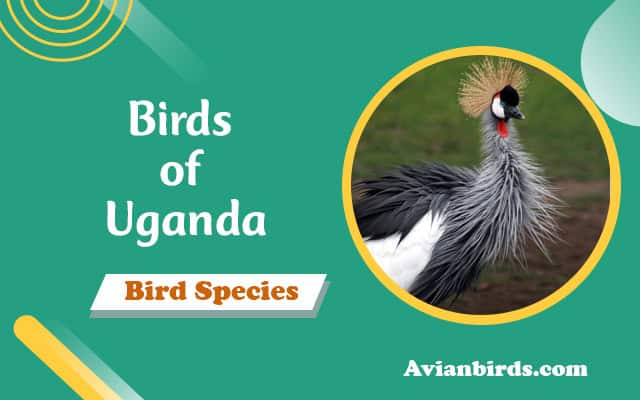15 Birds of Uganda (ID Guide With Pictures)
In this article, I’ve researched the Birds of Uganda and discovered a world full of beauty and diversity. Uganda is home to over 1,000 species, making it a birdwatcher’s paradise. Every bird tells a unique story, from vibrant turacos to the rare shoebill. Whether you’re new to birding or an expert, there’s always something to marvel at. I’ll share my favourite finds and tips for spotting them. Let’s explore Uganda’s incredible birdlife together!
1. Shoebill
- Scientific Name: Balaeniceps rex
- Size: 4 to 5 feet (1.2 to 1.5 meters)
- Weight: 11 to 15 pounds (5 to 7 kg)
- Lifespan: 35 to 50 years in captivity
- Diet: Fish, amphibians, reptiles, small birds
The Shoebill is one of the most iconic Birds of Uganda, often considered a living dinosaur due to its prehistoric appearance. With its enormous shoe-shaped bill and striking blue-gray plumage, this bird commands attention in the swamps and wetlands it calls home.Standing at about four feet tall, the Shoebill is an impressive sight. It primarily inhabits areas like the Mabamba Swamp near Lake Victoria, where it hunts for fish such as lungfish and tilapia. Its hunting technique is fascinating; the Shoebill stands still for long periods before swiftly striking down with its massive bill.

Despite being somewhat aloof, spotting a Shoebill can be exhilarating. Their eerie calls echo through their marshy habitats, adding to their mystique. Birdwatchers are often thrilled when they see this magnificent creature in action, making it a must-see during any trip to Uganda.
2. Grey Crowned Crane
- Scientific Name: Balearica regulorum
- Size: 3 to 4 feet (0.9 to 1.2 meters)
- Weight: 5.5 to 8.8 pounds (2.5 to 4 kg)
- Lifespan: 20 to 40 years in captivity
- Diet: Grains, seeds, insects, and small vertebrates
The Grey Crowned Crane is a striking bird gracing Uganda’s wetlands. With its elegant posture and vibrant plumage, it’s hard to miss. The golden crown of feathers atop its head gives this crane an unmistakable regal presence.
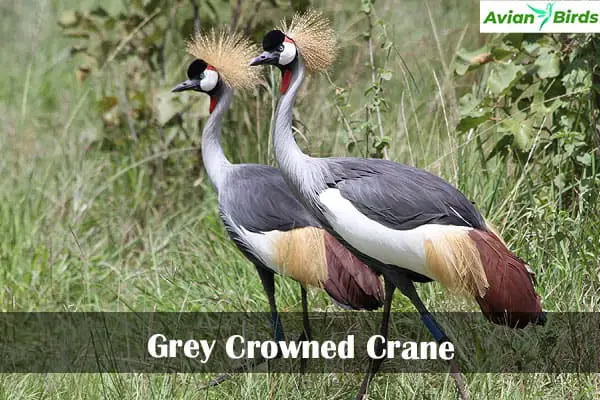
These cranes thrive in open grasslands and marshy areas. They are often seen foraging for food in pairs or small groups, searching for seeds, insects, and small reptiles. Their dance displays during courtship are mesmerizing—a blend of graceful movements and unique vocalizations.
Despite their beauty, Grey Crowned Cranes face threats from habitat loss and hunting. Conservation efforts are critical to ensuring their survival in the wild. Birdwatchers flock to see these magnificent creatures, making them one of Uganda’s most iconic species to spot among the diverse avifauna found throughout the country.
3. Great Blue Turaco
- Scientific Name: Tauraco malabaricum
- Size: 25 to 28 inches (64 to 71 cm)
- Weight: 1.5 to 2.5 pounds (0.7 to 1.1 kg)
- Lifespan: Up to 15 years in captivity
- Diet: Fruits, leaves, flowers, and seeds
The Great Blue Turaco is a stunning sight against the lush green backdrop of Uganda’s forests. This bird boasts vibrant blue plumage accented by striking red wing patches and a distinctive crest on its head.
Often referred to as the “turquoise king,” it moves gracefully through trees, making it a favorite among birdwatchers. The turaco’s calls are equally captivating—melodious and resonant, echoing through the canopy.
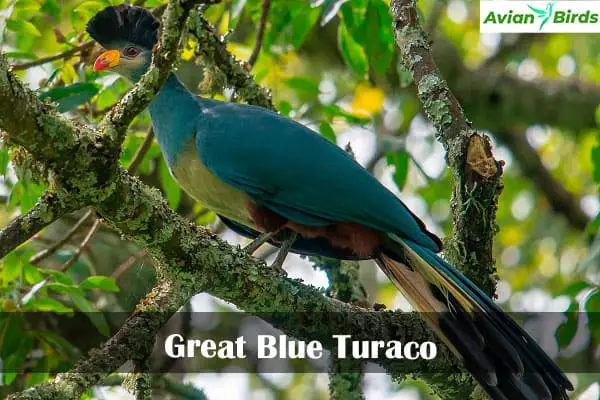
These birds primarily feed on fruits, especially figs, but will also snack on flowers and leaves. Their diet plays a crucial role in seed dispersal within their habitats.
Spotting one can be challenging due to their preference for dense foliage. However, patience rewards avid nature enthusiasts with unforgettable glimpses of this avian jewel soaring or perched elegantly amidst branches.
4. African Fish Eagle
- Scientific Name: Haliaeetus vocifer
- Size: 2 to 3 feet (60 to 75 cm)
- Weight: 3 to 6.5 pounds (1.4 to 3 kg)
- Lifespan: 10 to 20 years in the wild; up to 28 years in captivity
- Diet: Primarily fish, but also small mammals, birds, and carrion
The African Fish Eagles are an iconic bird of Uganda, easily recognized by their striking appearance. This majestic raptor often commands attention with a white head and tail contrasting against dark brown wings.
Found near lakes and rivers, it has a keen eye for spotting fish swimming below the surface. Its sharp talons are perfectly designed for snatching prey in mid-flight. Watching one dive gracefully into the water is truly mesmerizing.

These eagles are also known for their distinctive call—a series of high-pitched whistles that echo over waterways. Many birdwatchers consider their presence a highlight during excursions.
Nesting high in trees close to water bodies, they build large nests adorned with sticks and leaves. The sight of young eaglets peering from the nest adds to the allure of these magnificent birds.
5. Abyssinian Ground Hornbill
- Scientific Name: Bucorvus abyssinicus
- Size: 3 to 4 feet (0.9 to 1.2 meters)
- Weight: 4 to 10.5 pounds (1.8 to 4.8 kg)
- Lifespan: 30 to 50 years in captivity
- Diet: Insects, small mammals, reptiles, and fruits
The Abyssinian Ground Hornbill is a striking birds native to the African savannahs, particularly in Uganda. Its vivid blue throat pouch and large size make it an impressive sight. This hornbill stands out among other birds with its black plumage and red facial skin.
These social creatures are often spotted in small groups, foraging on the ground for insects, mammals, and fruits. Their loud calls echo through the open landscapes, adding a unique auditory experience to any wildlife excursion.
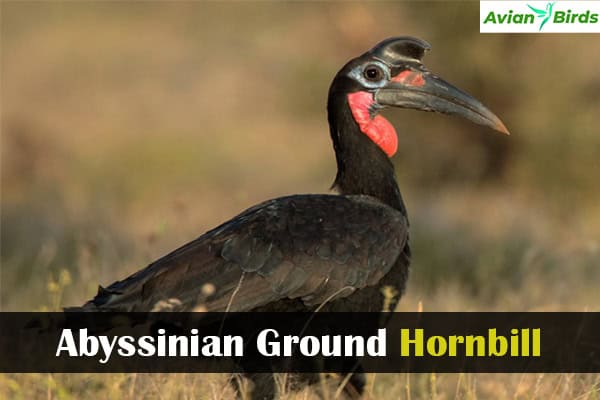
What’s fascinating about their nesting behaviour is that they typically nest in tree cavities but rely heavily on their partners during brood-rearing. This strong bond helps ensure the survival of their young.
Birdwatchers will appreciate their somewhat slow movements as they roam across grasslands or scrubby areas looking for food. Spotting an Abyssinian Ground Hornbill can highlight any birding adventure in Uganda’s rich ecosystems.
6. Hartlaub’s Bustard
- Scientific Name: Lissotis hartlaubi
- Size: 20 to 25 inches (50 to 65 cm)
- Weight: 4 to 8.5 pounds (1.8 to 3.8 kg)
- Lifespan: 10 to 15 years in the wild
- Diet: Seeds, grasses, insects, and small invertebrates
Hartlaub’s Bustard is a remarkable bird native to the grasslands and savannas of Uganda. With its distinctive plumage, it showcases a combination of browns and whites, making it blend beautifully into its surroundings.
This elusive bird often prefers open habitats where it can forage for seeds and insects. Its behavior is fascinating; Hartlaub’s Bustard tends to be more active during the early mornings or late afternoons when temperatures are cooler.
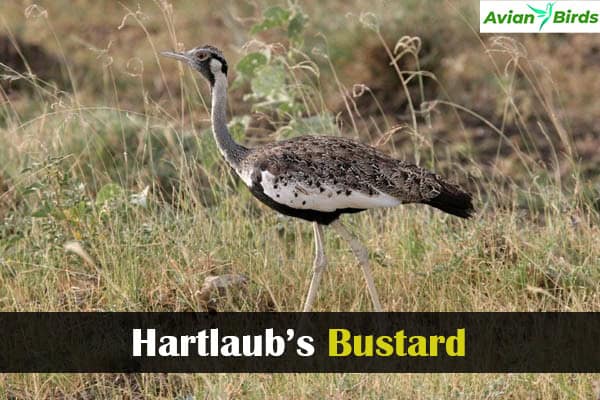
Birdwatchers cherish sightings of this species due to its rarity. Spotting one requires patience and keen observation skills. The male performs an impressive display during courtship, puffing up his chest while emitting deep booming calls that resonate across the plains.
Understanding their habitat needs enhances your chances of encountering these stunning birds on your next expedition in Uganda’s wild landscapes.
7. Black-and-white-casqued Hornbill
- Scientific Name: Bycanistes subcylindricus
- Size: 24 to 30 inches (61 to 76 cm)
- Weight: 4.5 to 8.5 pounds (2 to 4 kg)
- Lifespan: Up to 30 years in captivity
- Diet: Fruits, seeds, insects, and small vertebrates
The Black-and-white-casqued Hornbill is a striking sight against Uganda’s lush landscapes. With its prominent black-and-white plumage, this elegant bird is hard to miss. The large casque atop its bill adds an air of majesty.
These hornbills are often found in tropical rainforests, where they thrive among tall trees. Listen closely for their distinct calls echoing through the canopy; they communicate in various sounds.

Their diet mainly consists of fruits, insects, and small vertebrates. This adaptability allows them to play a vital role in seed dispersion within their habitat.
Observing these birds can be quite rewarding as they navigate through the treetops with grace. Their unique behaviour and social structures make them fascinating subjects for birdwatchers and nature enthusiasts.
8. Regal sunbird
- Scientific Name: Nectarinia regia
- Size: 4.5 to 5.5 inches (11 to 14 cm)
- Weight: 0.3 to 0.4 ounces (8 to 12 grams)
- Lifespan: Approximately 3 to 5 years in the wild
- Diet: Nectar, insects, and fruits
The Regal Sunbird is a dazzling sight in the forests of Uganda. With its iridescent plumage, this bird effortlessly captures attention. The male flaunts vibrant hues of green and blue, contrasted by striking red accents.
These sunbirds Birds of Uganda often flit through the canopy, feeding on nectar from various flowers. Their long, slender bills are perfectly adapted for reaching deep into blossoms. This diet sustains them and plays a vital role in pollination.

During the breeding season, they perform intricate courtship displays to attract females. Their melodious calls echo through the trees, adding to their charm. Spotting a Regal Sunbird is truly a delight for any birdwatcher lucky enough to visit Uganda’s lush landscapes.
Photographers will find capturing these feathered jewels in action challenging yet rewarding as they move gracefully among branches and blooms.
9. Rwenzori batis
- Scientific Name: Batis diops
- Size: 5.5 to 6.5 inches (14 to 16.5 cm)
- Weight: Approximately 0.5 ounces (14 grams)
- Lifespan: Around 5 to 7 years in the wild
- Diet: Insects, spiders, and other small invertebrates
The Rwenzori batis is a striking bird native to the misty forests of the Rwenzori Mountains. Its vibrant blue and yellow plumage stands out against the lush green backdrop.
This small, elusive creature prefers dense undergrowth and can often be heard before it’s seen. Its melodious calls echo through the trees, creating a symphony that delights any keen birdwatcher.

Feeding primarily on insects, the Rwenzori batis displays fascinating hunting techniques. It flits from branch to branch, pouncing swiftly on unsuspecting prey below.
Observing this bird in its natural habitat offers an exhilarating experience for nature lovers. The combination of beauty and rarity makes spotting one a memorable event during your Uganda adventure.
10. Bar-tailed trogon
- Scientific Name: Harpactes marked
- Size: 12 to 13 inches (30 to 33 cm)
- Weight: Approximately 3.5 to 4.5 ounces (100 to 130 grams)
- Lifespan: About 5 to 10 years in the wild
- Diet: Fruits, insects, and other small invertebrates
The Bar-tailed Trogon Birds of Uganda is a striking bird renowned for its vivid plumage and unique characteristics. This species boasts a beautiful combination of rich colours that often leave birdwatchers in awe.
With a bright green back and stunning red underparts, the male’s appearance is nothing short of spectacular. Females, while less vibrant, showcase subtle shades of brown that blend seamlessly into their surroundings.

These trogons prefer dense forests where they can quietly perch on tree branches, scanning for insects and fruits. Their distinctive calls echo through the treetops, adding to the symphony of sounds found in Uganda’s lush habitats.
Spotting a Bar-tailed Trogon requires patience and keen observation skills. Once you catch sight of this elusive bird, it feels like an incredible reward for your efforts. Each encounter with this avian beauty adds depth to any birdwatching experience in Uganda’s diverse landscapes.
11. Green-breasted Pitta
- Scientific Name: Pitta reichenowi
- Size: 8 to 9 inches (20 to 23 cm)
- Weight: Approximately 3.5 to 4.5 ounces (100 to 130 grams)
- Lifespan: About 5 to 10 years in the wild
- Diet: Insects, worms, and small invertebrates, along with fruits and seeds
The Green-breasted Pitta Birds of Uganda is a strikingly beautiful bird that captivates with its vibrant plumage. Its vivid green wings and bright red underparts make it stand out in the dense foliage of Uganda’s forests.
This elusive creature prefers to stay hidden, often foraging on the forest floor for insects and snails. Observing one requires patience and keen eyes, as they tend to remain still amidst the leaves.
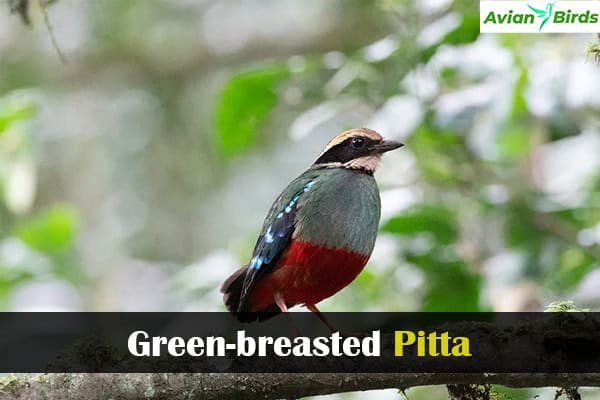
During the breeding season, males can sing melodious tunes and mark their territory with a series of soft whistles. Their calls add an enchanting layer to the sounds of the rainforest.
Birdwatchers often seek this gem during their expeditions, hoping for a glimpse or perhaps just a fleeting flash of colour through the trees. The thrill lies in spotting them and experiencing their unique behaviours in their natural habitat.
12. Grauer’s Broadbill
- Scientific Name: Pseudocalyptomena graueri
- Size: 25–27 cm
- Weight: 80–90 g
- Lifespan: ~15 years
- Diet: Fruits, berries, and insects.
Grauer’s Broadbill is a striking bird found primarily in the dense forests of the eastern Democratic Republic of Congo, with occasional sightings in Uganda. This elusive species is notable for its vibrant plumage, which ranges from emerald green to deep blue.
Its broad bill and unique coloration stand out among the canopy dwellers. Observing this bird can be challenging due to its preference for thick underbrush, where it hunts insects and fruit.
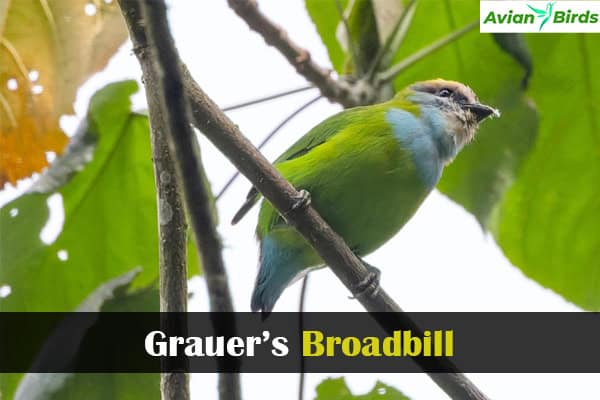
The Grauer’s Broadbill Birds of Uganda has a distinctive call that resonates through the forest. Birdwatchers often listen carefully before spotting this gem hidden among leaves. Its shy nature adds an element of thrill to any birding expedition.
Conservation efforts are crucial as habitat loss threatens their population. Engaging with local conservation projects can help protect these beautiful creatures while enjoying Uganda’s rich avian biodiversity.
13. Shelly’s Crimsonwing
- Scientific Name: Cryptospiza shelleyi
- Size: Approximately 12–13 cm
- Weight: Around 10–12 g
- Lifespan: Estimated to be around 5–10 years in the wild
- Diet: Primarily seeds, fruits, and insects.
Shelly’s Crimsonwing is a vibrant gem among Uganda’s avian treasures. This elusive bird captures the imagination with its striking crimson plumage and distinctive black wings. Found primarily in the dense undergrowth of montane forests, it often remains hidden from view.
Birdwatchers are drawn to the challenge of spotting this rare species. Its haunting calls echo through the trees, creating an enchanting atmosphere for those lucky enough to be in its presence.
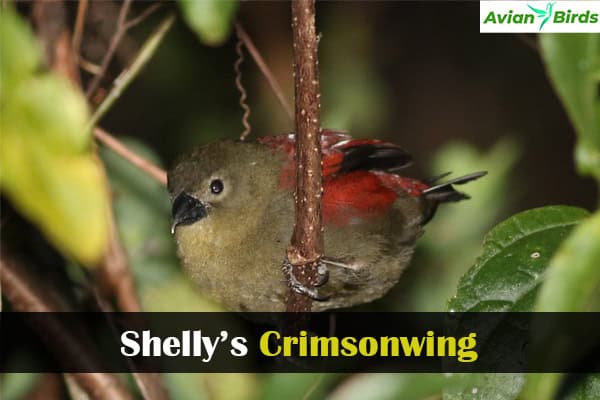
Typically seen foraging on or near the forest floor, Shelly’s Crimsonwing feeds on seeds and insects. The male displays brilliant colours during courtship rituals, showcasing nature’s artistry at play.
To fully appreciate this beautiful bird, patience is key. Observing it requires keen eyes and quiet footsteps in its preferred habitat—an experience that can leave lasting memories for any avid birder exploring Uganda’s lush landscapes.
14. Handsome spurfowl
- Scientific Name: Pternistis nobilis
- Size: Approximately 33–38 cm in length
- Weight: Around 400–600 grams
- Lifespan: Up to 10–15 years in the wild
- Diet: Omnivorous; feeds on seeds, fruits, small invertebrates, and plant material
The Handsome Spurfowl Birds of Uganda are striking birds that captivate with their vibrant plumage and distinctive markings. Males showcase deep chestnut feathers adorned with intricate patterns. Their unique spurs give them their name and remind them of their impressive presence.
These birds are mostly ground-dwelling, preferring dense forests and thickets where they can forage for seeds, fruits, and insects. Due to their subtle behaviours, observing them in the wild is a delightful experience.
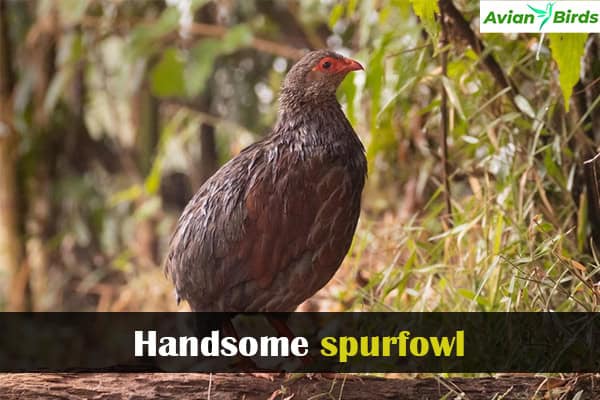
Their calls echo through the underbrush—a series of soft clucks that add an enchanting soundtrack to any birdwatching trip. While they may be elusive at times, patience often rewards keen observers.
Spotting this exquisite species adds excitement to any list of Birds of Uganda. With every sighting comes an appreciation for the diversity that this stunning destination offers ornithologists and nature lovers alike.
15. Elgon Francolin
- Scientific Name: Scleroptila elgonensis
- Size: Approximately 30–35 cm in length
- Weight: Around 350–450 grams
- Lifespan: Estimated 5–8 years in the wild
- Diet: Omnivorous; primarily feeds on seeds, insects, and small invertebrates
The Elgon Francolin Birds of Uganda is a captivating bird native to the mountainous regions of Uganda, particularly around Mount Elgon. With its striking plumage, this species showcases rich brown and chestnut tones that blend seamlessly with its natural habitat.
These birds prefer dense undergrowth and grasslands at higher altitudes. They are often seen in small groups foraging on the ground for seeds and insects. Their unique call resonates through the forests, adding a melodic touch to the tranquil environment.

Unlike many other francolins, they exhibit a level of shyness that makes spotting them an exciting challenge for birdwatchers. Patience is key when observing their behaviours as they tend to remain hidden among foliage until disturbed.
The Elgon Francolin’s presence is significant not only ecologically but also in adding vibrant beauty to Uganda’s avian diversity. Every sighting offers a glimpse into the rich tapestry of life surrounding these remarkable mountains.
Best Locations for Birdwatching in Uganda
Uganda boasts a variety of birdwatching hotspots that cater to enthusiasts at all levels.
Murchison Falls National Park is a must-visit, with its diverse ecosystems attracting countless species. The Nile River adds beauty while hosting aquatic birds like the African Fish Eagle.
Queen Elizabeth National Park offers stunning landscapes and rich biodiversity. Visitors can spot the iconic Grey Crowned Crane, among other fascinating avian life.
For those seeking tranquillity, Lake Mburo National Park is perfect. Its wetlands are alive with vibrant birdlife, including the elusive Shoebill.
Kibale Forest also stands out for its unique selection of forest-dwelling birds. Listen for calls from colourful species flitting through the trees.
Bwindi Impenetrable Forest showcases endemic birds in breathtaking surroundings. This UNESCO World Heritage site promises rewarding sightings amidst lush greenery and towering mountains.
Tips for Identifying Birds in the Field
Identifying birds in the field can be a delightful challenge. Start by observing their size and shape. Note whether they are large or small, plump or slender.
Next, pay attention to the colours and patterns on their feathers. Brightly coloured birds often stand out against greenery, making them easier to spot.
Listen carefully to their calls and songs; many species have distinct sounds that can help you pinpoint them even when they’re hidden from view.
Use binoculars for a closer look without disturbing them. A good pair enhances detail recognition while allowing you to enjoy the beauty of these creatures from afar.
Always keep your field guide handy. These books offer valuable information on various species, including images for comparison.
Practice patience. Birds may not always appear immediately, but waiting quietly often rewards you with unforgettable sightings.
Conclusion
Birds of Uganda is a birdwatcher’s paradise, brimming with avian life. Each species offers something unique, from striking colours to captivating behaviours.
Exploring the diverse landscapes reveals hidden gems among the trees and wetlands. Every outing can lead to delightful discoveries.
Birds like the Shoebill or Grey Crowned Crane showcase nature’s artistry. Their presence adds magic to Uganda’s rich biodiversity.
Whether you’re an avid birder or just curious, Uganda promises unforgettable experiences. The thrill of spotting your first Regal Sunbird or Grauer’s Broadbill will linger long after your visit.
As you venture out into this vibrant ecosystem, remember that patience and curiosity are key companions on your journey through Uganda’s skies.
Read more🐦Related Articles:
- Birds With Red Heads in the UK
- The Ultimate Guide to Storing Birdseed
- Owls in Idaho
- Hummingbirds In Virginia
- Yellow-legged Gull (Larus michahellis)
- Florida Birds Of Prey
FAQ’S
Q1. What is the best time for birdwatching in Uganda?
The ideal time for birdwatching in Uganda is during the dry seasons, from December to February and June to August. During these months, migratory birds visit, and local species are more active.
Q2. What bird is on Uganda’s flag?
The bird on Uganda’s flag is the Grey-Crowned Crane. It symbolizes elegance, representing Uganda’s beauty and the nation’s pride.
Q3. What are the national birds of Uganda?
The national bird of Uganda is the Grey Crowned Crane. It’s known for its striking appearance and graceful movements.
Q4. What is the big bird in Uganda?
The big bird in Uganda is the Shoebill. It’s known for its large size and distinctive, shoe-shaped bill. This rare and prehistoric-looking bird is a favourite among birdwatchers.

